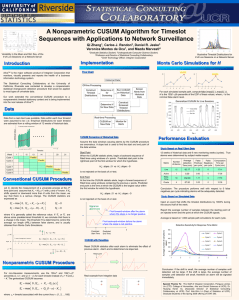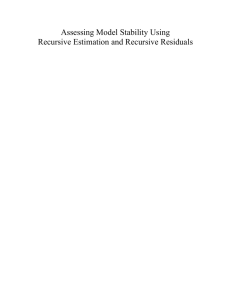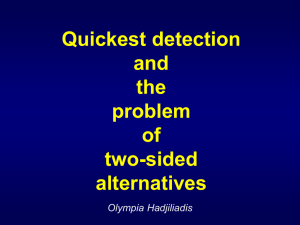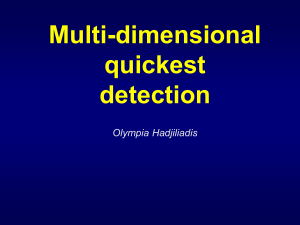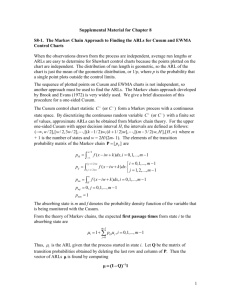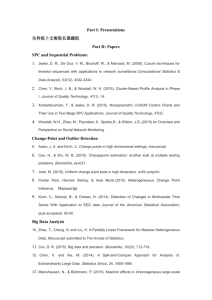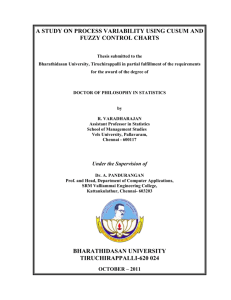for Online Strength Monitoring of Ready Mixed Concrete
advertisement
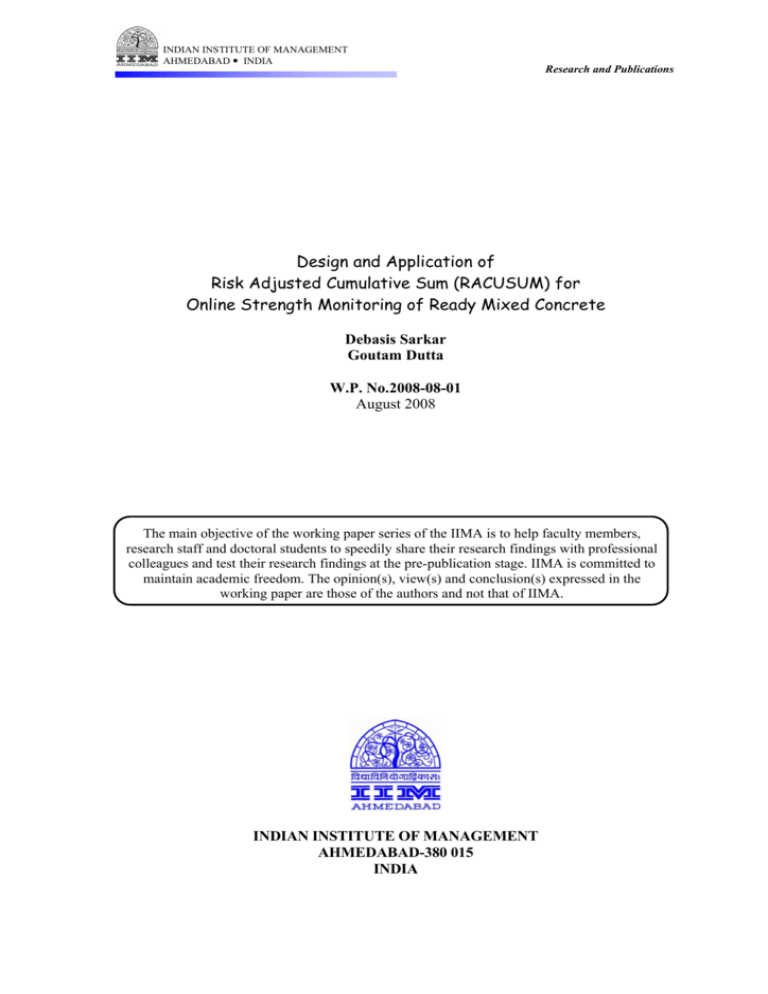
INDIAN INSTITUTE OF MANAGEMENT AHMEDABAD y INDIA Research and Publications Design and Application of Risk Adjusted Cumulative Sum (RACUSUM) for Online Strength Monitoring of Ready Mixed Concrete Debasis Sarkar Goutam Dutta W.P. No.2008-08-01 August 2008 The main objective of the working paper series of the IIMA is to help faculty members, research staff and doctoral students to speedily share their research findings with professional colleagues and test their research findings at the pre-publication stage. IIMA is committed to maintain academic freedom. The opinion(s), view(s) and conclusion(s) expressed in the working paper are those of the authors and not that of IIMA. INDIAN INSTITUTE OF MANAGEMENT AHMEDABAD-380 015 INDIA IIMA y INDIA Research and Publications Design and Application of Risk Adjusted Cumulative Sum (RACUSUM) for Online Strength Monitoring of Ready Mixed Concrete Debasis Sarkar1 Goutam Dutta2 Abstract The Cumulative Sum (CUSUM) procedure is an effective statistical process control tool that can be used to monitor quality of ready mixed concrete (RMC) during its production process. Online quality monitoring refers to monitoring of the concrete quality at the RMC plant during its production process. In this paper, we attempt to design and apply a new CUSUM procedure for RMC industry which takes care of the risks involved and associated with the production of RMC. This new procedure can be termed as Risk Adjusted CUSUM (RACUSUM). The 28 days characteristic cube compressive strengths of the various grades of concrete and detailed information regarding the production process and the risks associated with the production of RMC were collected from the operational RMC plants in and around Ahmedabad and Delhi (India). The risks are quantified using a likelihood based scoring method. Finally a Risk Adjusted CUSUM model is developed by imposing the weighted score of the estimated risks on the conventional CUSUM plot. This model is a more effective and realistic tool for monitoring the strength of RMC. CE Database subject headings: Strength monitoring, Ready Mixed Concrete (RMC), Cumulative Sum (CUSUM); Risk adjusted CUSUM (RACUSUM). 1 Assistant Professor, Construction & Project Management, Faculty of Technology, CEPT University, Ahmedabad, Gujarat, India. 2 Professor, Production & Quantitative Methods, Indian Institute of Management, Ahmedabad, Gujarat, India. W.P. No. 2008-08-01 Page No. 2 IIMA y INDIA Research and Publications 1. Introduction The Cumulative Sum (CUSUM) is an important statistical process control technique for the monitoring and analysis of strengths of ready mixed concrete. The compressive strength of concrete cubes is generally tested at the end of 3 days, 7 days and 28 days. The CUSUM is the cumulative sum of deviations of actual compressive strengths obtained from the target mean compressive strength of the specified grade of concrete. To apply CUSUM technique in the RMC industry, practitioners should compare the test results of the concrete grades with the desired values and check whether they are consistent with the required levels of compliance. In applying this technique, the target compressive strength value is subtracted from each of observations (or sample), providing positive and negative differences. These differences are added to obtain the CUSUM. When this cumulative sum is plotted graphically against the sequence of results, a visual presentation of the trend relative to the target level is produced. This conventional representation of CUSUM does not consider the operational risks during the production of RMC. In this paper we propose a method of incorporating operational risks that become a part of the overall project risk management. The paper is organized in the following manner. In section 2 we deal with the literature survey which comprises the available literature on CUSUM and other closely related SPC techniques over the past twenty years. Section 3 deals with the conceptual framework for developing the risk adjusted CUSUM model. Section 4 deals with the proposed Risk Adjusted CUSUM (RACUSUM) model. Section 5 deals with the case study and application of the conventional CUSUM model and RACUSUM model for strength monitoring of RMC. Lastly, in section 6, we discuss about the conclusions inferred from this research work and also the extension and scope for further research in this area. 2. Literature Survey In this section, we discuss the research work done by eminent researchers over the last twenty years, on CUSUM and other closely related SPC techniques. CUSUM charts were first proposed by Page (1954) and since then have been studied by Barnard (1959), Johnson (1961), Kemp (1961), Johnson and Leone (1962), Ewan (1963), W.P. No. 2008-08-01 Page No. 3 IIMA y INDIA Research and Publications Goel (1968), Taylor (1968), Goel and Wu (1973), Chiu (1974), Lucas (1976, 1982), Montgomery (1980,1985), Woodall (1985), Lorenzen and Vance (1986), Deming (1986), Ramfrez and Juan (1989), Gan (1991), Box and Ramirez (1992), Steiner and Cook (2000), Yeh, Lin, and Venkataramani (2004). Montgomery (1985), in his research on control charts, was of the view that these charts are amongst some of the most important management control tools. These charts have a long history of use in industries across the globe. The five basic reasons behind this are as follows: (i) control charts are proven techniques for improving productivity; (ii) they are effective in defect prevention; (iii) they prevent unnecessary process adjustments; (iv) they provide diagnostic information; and (v) they provide information about process capability. Though the CUSUM control charts were proposed by Page (1954), the Shewhart charts were more popular and widely used than the CUSUM charts. Montgomery pointed out that a major disadvantage with any of the Shewhart charts was that it only used the information about the process contained in the last plotted point, and ignored information given by the entire sequence of points. The CUSUM chart is, therefore, a better alternative to the Shewhart chart, since it directly incorporates all the information in the sequence of sample values by plotting the cumulative sums of the deviations of the sample values from a target value. For sample sizes n ≥ 1, if xi is the average of the i th sample and µ0 is the target for the process mean, the CUSUM chart is formed by plotting the quantity Sm = Σ ( xi – µ0 ) where i = 1, 2,…m against the sample number m. Here Sm is the cumulative sum upto and including the mth sample. As they combine information from several samples, CUSUM charts are more effective than Shewhart charts for detecting small process shifts. If the process remains in control at the target value µ0, the CUSUM defined in the above equation should vary randomly about zero. However, if the mean shifts upward to some value µ1 > µ0, then an upward or positive drift will develop in the CUSUM Sm. Conversely, if the mean shifts downward to some value µ2 < µ0, then a downward or negative drift in Sm will develop. W.P. No. 2008-08-01 Page No. 4 IIMA y INDIA Research and Publications Therefore, if a trend develops in the plotted points - either upward or downward, we should consider this as evidence that the process mean has shifted, and a search for some assignable cause should be initiated. For determining whether the process is out of control, a formal decision procedure can be laid down in the form of a truncated V-shaped mask popularly known as V-mask proposed by Barnard (1959). Deming (1986) strongly advocated the use of control charts (CUSUM, Exponentially Weighted Moving Average (EWMA), Shewhart charts) as effective SPC tools for quality monitoring, but he was not in favor of the use of hypothesis testing. His research highlights that CUSUM and EWMA charts are more effective than Shewhart charts in detecting small and moderate sized sustained shifts in the parameters of the probability distribution of a quality characteristic. Though in some cases CUSUM and EWMA charts are very useful, they are not meant to replace the Shewhart chart which can be used to detect a wider assortment of effects due to assignable causes. It is, therefore, frequently recommended that Shewhart limits be used in conjunction with CUSUM or EWMA charts. Apley et al. (1999) worked on SPC techniques based on the Generalized Likelihood Ratio Test (GLRT) for detecting and estimating mean shifts in autocorrelated processes. As per their observations, sometimes the performance of the GLRT models are slightly better than CUSUM, but for some cases, either the difference is negligible, or the performance of CUSUM is better. Woodall (2000) worked on SPC methods, particularly control charts, which are major tools used for monitoring and improving manufacturing processes and service operations. His view was that practitioners need to develop a better understanding of how SPC research can improve the use of methods in practice. Steiner et al. (2000) proposed a risk adjusted CUSUM model as applicable to the medical profession. This proposed model can be used to monitor surgical performance. Pignatiello et al. (2001) conducted research on the estimation of change points of the normal process mean in SPC applications. This research work reveals the fact that control charts play an important role in SPC applications and these charts are used to monitor for process changes by distinguishing between special and common causes of variation. Yeh. et al. (2004) proposed two new CUSUM control charts - the CUSUM M-chart which is specifically designed for detecting small shifts in process mean, and the CUSUM Vchart designed for detecting small changes in process variability. A combined CUSUM M W.P. No. 2008-08-01 Page No. 5 IIMA y INDIA Research and Publications and V chart provides a unified scheme in the monitoring of the process mean and variability. This is particularly useful when there are multiple processes to be monitored, since all quality characteristics can be monitored in a single chart. Although most researchers have proved that CUSUM control charts can be effectively used for reducing process variability - which is the eventual goal of SPC - minimal attempts have been made to apply the CUSUM technique as an effective quality monitoring tool in the construction industry, especially in the Indian context. Our research is an effort to investigate how effectively the CUSUM technique can be applied as a quality monitoring tool for Indian construction, especially in the RMC industry. In reality, some risks are involved during the production of RMC in commercial batching plants. These can be taken care of and incorporated in a conventional CUSUM plot and this proposed risk adjusted CUSUM (RACUSUM) model will be a more effective tool for monitoring the quality of RMC. Like the conventional CUSUM plot, the RACUSUM can be effectively used for monitoring mean strength, standard deviation and range of cube compressive strength samples of various grades (M15, M20, M25, M30, M40 …) of concrete produced by RMC plants. Reviewing the work of researchers like Box et. al. (1992), it has been found that they have considered process monitoring as a system of continuous statistical hypothesis testing. Vining (1998) also viewed control charts as a sequence of hypothesis tests. He then justified the use of hypothesis testing by stating that it better reflects statistical thinking in showing ties between two important areas of statistics which provided a formal basis for evaluating properties of control charts. Deming (1986) strongly advocated the use of control charts and justified the use of CUSUM charts. Apley et.al. (1999) worked on GLRT models and observed that in some cases the performance of these models is better than the CUSUM models; in some cases, their performance is at par and in others, CUSUM performs slightly better. Though the work of these researchers is well appreciated, a model, where the CUSUM technique can be applied in conjunction with the hypothesis testing principle and GLR principles and concepts, with specific reference to the RMC industry, was lacking. The W.P. No. 2008-08-01 Page No. 6 IIMA y INDIA Research and Publications proposed RACUSUM model has been developed based on the concepts of CUSUM technique in conjunction with the concepts of hypothesis testing and GLR, and can be applied to monitor the strength of ready mixed concrete. We feel that this model will be a more effective and realistic model applicable to the RMC industry. 3. Conceptual Framework We define the variables as follows: Xt = cumulative sum of deviations of the target mean strength from the actual observed 28 days compressive strength (mean of three cube strengths) of the tth sample t Dt = the corresponding sample number (1,2,3….) = is the deviation of the target mean strength from the actual observed cube strength of the tth sample. = pt risk estimated for the tth sample based on the probability of occurrence (likelihood) of the risks during production Wt = logarithmic likelihood sample weight or score assigned to the tth sample depending on the estimated risk H0 = null hypothesis HA = alternate hypothesis θ = change in process parameter (specified concrete strength) θ0 = change in process parameter under null hypothesis θA = change in process parameter under alternate hypothesis C0 = current acceptable level of strength CA = significant change in level of strength OR0 = odds ratio under null hypothesis ORA = odds ratio under alternate hypothesis yt = actual outcome of sample strength (acceptance =1, rejection = 0) RAXt = risk adjusted cumulative sum of deviations of target mean strength from observed 28 days compressive strength A standard tabular CUSUM involves monitoring of Xt = max (0, Xt-1 + Dt), t = 1,2,3….. where X0 = 0. The CUSUM in the above stated equation sequentially tests the hypothesis W.P. No. 2008-08-01 Page No. 7 IIMA y INDIA Research and Publications H0 : θ = θ0 and HA : θ = θA. Here θ0 is typically determined by the current performance and θA is an alternate value of interest, corresponding typically to inferior performance. The process is assumed to be in state H0 as long as Xt is within control limits and is deemed to have shifted to state HA if Xt goes beyond the control limit. A CUSUM that exceeds the control limit is said to have “signaled” (signal means that the chart has accumulated enough evidence to conclude that the process parameter has changed). CUSUM is designed to monitor the responses sequentially until sufficient evidence of process deterioration is detected. Thus theoretically the CUSUM will eventually signal the change although the signal may be a false alarm. The run length of the CUSUM is the time or number of observations required before the CUSUM first exceeds the control limit. Good choices for the control limit h are based on the expected or average run length (ARL) of the CUSUM under H0 and HA. Ideally, while the process is in state H0, the run length should be long, since in this context signals represent false alarms. On the other hand, if the process has shifted to θA, or any other process, setting substantial difference than θ0, short ARLs are preferred. The design of the tabular CUSUM can be modified by incorporating a sample weight based on the loglikelihood ratio. The monitoring equation becomes Xt = max (0, Xt-1 + Dt + Wt) where “Wt” is the sample weight or score assigned to the tth sample. If “y” represents the current outcome, and denotes the probability distribution of the possible subgroup outcomes f (y ; θ ) , the log-likelihood ratio is ln (f (y ; θA ) / f ( y ; θ0 ) ). This choice is optimal in the sense that, among all schemes with the same ARL under H0 , the log-likelihood ratio weights give the smallest ARL under HA. When applying the standard methodology to monitor the compressive strength, it is necessary to update the CUSUM after each strength is obtained from the strength test for the specified concrete grades. This helps to detect changes as quickly as possible. The outcome “y” corresponds to one of the two possible outcomes (success or failure) i.e. whether the obtained strength is more or less than the minimum specified strength. The CUSUM is the cumulative sum of scores taken over all the strengths monitored. Assuming yt is the outcome for strength of sample t, and yt = 1, if the obtained strength is greater than the minimum specified strength and yt = 0, if the obtained strength is less than the minimum specified strength. Thus f ( yt / θ ) = p (θ) yt ( 1 – p (θ) ) 1 – yt where p(θ0) = C0 , the estimated current acceptable level of strength, p(θA) = CA , is an important change in the strength level. As a result, the CUSUM sequentially tests the hypothesis H0 p = C0 versus HA p = CA and W.P. No. 2008-08-01 Page No. 8 IIMA y INDIA Research and Publications the CUSUM scores are Wt = log ( [ 1- CA ] / [ 1- C0 ] ) if yt = 0 ; and Wt = log ( CA / C0 ) if yt =1. 4. Proposed Risk Adjusted CUSUM (RACUSUM) Model The proposed RACUSUM model is based on the likelihood ratio scoring method, the quantification of which involves parameters like estimated risk (pt), odds ratio under null hypothesis(OR0), odds ratio under alternate hypothesis (ORA) and actual outcome of sample strength (yt). The log likelihood score (Wt) thus obtained, when added to the conventional CUSUM values and the corresponding graphical plot, is termed as the RACUSUM plot. The CUSUM can be adjusted based on prior risk by adopting the magnitude of the scores on the basis of the risks the specified concrete grade may be subjected to. Since each monitored strength may have a different baseline risk level, the hypothesis H0 and HA are based on an odds ratio. Let OR0 and ORA represent the odds ratios under null and alternate hypothesis respectively. To detect increases, we can set ORA > OR0. The choice of ORA is similar to defining a minor risk which has a minimal effect on the quality of concrete. If the estimated risk pt is based on the current conditions, we may set OR0 = 1. Given an estimated risk of failure equal to pt , the odds of failures equals pt / ( 1 – pt ). Thus for strength of sample t under H0 , the odds of failure equals OR0 pt / (1- pt ) , whereas under HA the odds of failure equals ORA pt / ( 1 – pt ) which corresponds to a probability of failure equal to ORA pt / (1-pt + ORA pt ) under HA . In this way, the CUSUM repeatedly tests H0 : odds ratio = OR0 vs HA : odds ratio = ORA . Thus the two possible log-likelihood ratio scores for strength of sample ‘t’ proposed by us are Wt = log [ ((1 – pt + OR0 pt ) ORA) / (( 1- pt + ORA pt ) OR0 ) ] if yt = 1 ……. (1) Wt = log [ ( 1 – pt + OR0 pt) / ( 1 – pt + ORA pt )] if yt = 0 ……………….. (2) We then propose the ultimate equation for RACUSUM as: RAXt = Xt + Wt ……………………………. (3) 5. Case Study and Analysis of the RACUSUM Model 7 days and 28 days cube compressive strength data of various grades of concrete (M15, M20, M25, M30, M40) collected from the operational RMC plants in and around Ahmedabad and Delhi were analyzed using conventional CUSUM technique and VMask. With this technique, the RMC operators can monitor the strength of the concrete W.P. No. 2008-08-01 Page No. 9 IIMA y INDIA Research and Publications produced by them on daily, weekly or monthly basis. This would ensure that the quality of concrete produced by them is as per the specifications of the mix design. As a result, producers need not opt for an over-conservative mix design to reduce their risk, and can also avoid an unnecessary wastage of material. With this conventional CUSUM, the risks involved during the production of ready mixed concrete are incorporated into the existing model and a new model termed as “Risk Adjusted CUSUM Model” is developed. This model is likely to be a more effective and realistic model for monitoring the quality of RMC. The data considered for the demonstrative analysis is a batch of thirty samples (each sample is the mean of three cubes) of 28 day compressive strength of M20 grade concrete collected from a commercial batching plant in Ahmedabad. This batch taken for the duration of about one month is represented in Table 1. Table 1. Data of 28 day cube compressive strength considered for analysis (collected from a commercial RMC plant in Ahmedabad) Sample Date Of casting 28 day Compressive Strength N/mm2 (Mpa) (Mean of 3 cube strengths) (xt) No. (t) 1 20.05.06 35.50 2 20.05.06 27.80 3 22.05.06 35.80 4 22.05.06 30.10 5 23.05.06 27.60 6 25.05.06 32.45 7 25.05.06 30.20 8 26.05.06 26.85 9 28.05.06 31.10 10 30.05.06 19.20 11 02.06.06 25.86 12 03.06.06 31.20 13 03.06.06 25.60 14 04.06.06 31.15 15 06.06.06 35.80 16 07.06.06 27.50 17 09.06.06 28.73 18 10.06.06 23.20 W.P. No. 2008-08-01 Page No. 10 IIMA y INDIA Research and Publications 19 11.06.06 18.95 20 12.06.06 24.50 21 13.06.06 22.45 22 14.06.06 29.80 23 15.06.06 35.65 24 15.06.06 30.80 25 17.06.06 24.01 26 19.06.06 25.25 27 20.06.06 27.55 28 22.06.06 30.15 29 24.06.06 24.50 30 24.06.06 22.60 The estimated risks “pt” identified during the production process of RMC which are mainly associated with the deterioration of concrete strength, and their subsequent ratings based on experience, is given in Table 2. Table 2. Estimated risks associated with RMC production and their ratings S No. Description of identified risks Risk ratings (likelihood based) 1 Strength deterioration due to problematic raw materials 0.4 (cement, coarse aggregates, fine aggregates, admixtures etc.) 2 Strength deterioration due to problematic admixtures 0.2 3 Strength deterioration due to problematic water quality 0.1 4 Strength deterioration due to poor workmanship 0.3 during production process Summation of estimated risks (Σ pt) 1.0 For the data of M20 grade concrete as per Table 1, the basic analysis for formulating a conventional CUSUM chart is as follows: Sample Mean : 28.061 N/mm2 (Mpa) [ 1 Mpa = 1 N/mm2 ] Standard Deviation (σ ) : 4.601 ( Plant Standard Deviation of the batch under analysis) W.P. No. 2008-08-01 Page No. 11 IIMA y INDIA Research and Publications Target Mean Strength (TMS) = fck + 2 σ [Dewar and Anderson] = 20 + 2( 4.601) = 29.202 N/mm2 (Mpa) Formulation of data for the CUSUM plot is represented in Table 3. Column 1 of Table 3 represents sample number, column 2 represents the 28 days cube compressive strength (xt) and in column 3 the deviations (both positive and negative) of TMS (29.202 N/mm2) from xt are calculated. This data of the CUSUM values are plotted against the sample number (t) to obtain a graphical representation of the conventional CUSUM plot which is presented in column 4. Column 5 represents the ratings of the estimated risks identified for each sample of the same RMC plant under study. In column 6 the values obtained for Risk Adjusted CUSUM (RACUSUM) is presented. Now for the Risk Adjusted CUSUM, the basic analysis is as follows: Assuming Odds ratio under null hypothesis ORo = 1 and under alternate hypothesis ORA = 0.5, the ratings of estimated risks pt for sample 1, 2, 3, 4, ……..30 based on experience are tabulated in Table 3. Log likelihood scores of the samples 1, 2, 3, ….. 30 are calculated as follows: For RMC production, the basic criterion for acceptance of a particular concrete is that its strength does not fall below the specified strength, thus, for yt = 1 as per equation 1 Wt = log [ ( 1 – pt + ORo pt ) ORA / ( 1 – pt + ORA pt ) ORo ] Where Wt is the loglikelihood score of the tth sample considering estimated risk pt For, ORo = 1 and ORA = 0.5 Wt 1 = log [ (1 – 0.1 + 1(0.1)) 0.5 / ( 1 – 0.1 + 0.5 (0.1)) 1 ] = - 0.2787 Similarly Wt 2 = - 0.2304 Thus the table given below can be formulated using the above concepts. W.P. No. 2008-08-01 Page No. 12 INDIAN INSTITUTE OF MANAGEMENT AHMEDABAD y INDIA Research and Publications Table 3. Formulation of Risk Adjusted CUSUM (RACUSUM) for M20 grade concrete with Mean = 28.061 N/mm2 (Mpa), Standard deviation = 4.601, TMS = 29.202 N/mm2 (Mpa) Sample 28 D Compressive 2 Deviations CUSUM Estimated Risk (pt) Sample Weight Risk Adjusted Log likelihood CUSUM Score (Wt) N/mm2 (Mpa) (5) (6) (7) Strength N/mm (Mpa) (xt – TMS) (xt) 2 N/mm (Mpa) (1) (2) (3) 1 35.50 6.298 6.298 0.1 -0.2788 6.0192 2 27.80 -1.402 4.896 0.3 -0.2304 4.6656 3 35.80 6.598 11.494 0.1 -0.2788 11.2152 4 30.10 0.898 12.392 0.2 -0.2553 12.1367 5 27.60 -1.602 10.790 0.4 -0.2041 10.5859 6 32.45 3.248 14.038 0.1 -0.2788 13.7592 7 30.20 0.998 15.036 0.2 -0.2553 14.7807 8 26.85 -2.352 12.684 0.4 -0.2041 12.4798 9 31.10 1.898 14.582 0.2 -0.2553 14.3267 10 19.20 -10.002 4.580 0.7 -0.1139 4.4661 11 25.86 -3.342 1.238 0.4 -0.2041 1.0338 12 31.20 1.998 3.236 0.2 -0.2553 2.9807 13 25.60 -3.602 -0.366 0.4 -0.2041 -0.5701 14 31.15 1.948 1.582 0.2 -0.2552 1.3267 15 35.80 6.598 8.180 0.1 -0.2788 7.9012 No.(t) N/mm2 (Mpa) (4) IIMA y INDIA Research and Publications 16 27.50 -1.702 6.478 0.4 -0.2041 6.2738 17 28.73 -0.472 6.006 0.4 -0.2041 5.8018 18 23.20 -6.002 0.004 0.4 -0.2041 -0.2001 19 18.95 -10.252 -10.248 0.7 -0.1139 -10.3619 20 24.50 -4.702 -14.950 0.4 -0.2041 -15.1541 21 22.45 -6.752 -21.702 0.4 -0.2041 -21.9061 22 29.80 0.598 -21.104 0.3 -0.2304 -21.3344 23 35.65 6.448 -14.656 0.1 -0.2788 -14.9347 24 30.80 1.598 -13.058 0.2 -0.2553 -13.3132 25 24.01 -5.192 -18.250 0.4 -0.2041 -18.4541 26 25.25 -3.952 -22.202 0.4 -0.2041 -22.4061 27 27.55 -1.652 -23.854 0.4 -0.2041 -24.0581 28 30.15 0.948 -22.906 0.2 -0.2553 -23.1613 29 24.50 -4.702 -27.608 0.4 -0.2041 -27.8121 30 22.60 -6.602 -34.210 0.4 -0.2041 -34.4141 W.P. No. 2008-08-01 Page No. 14 IIMA y INDIA Research and Publications Fig: 1. Comparison of Conventional CUSUM Plot and RACUSUM Plot for M20 Concrete (as per data of Table 3.) W.P. No. 2008-08-01 Page No. 15 IIMA y INDIA Research and Publications Analysis of the Graphical Trend Obtained in Figure 1. In general, upward slopes indicate an increase in mean strength and standard deviation, and downward slopes reflect a reduction. Minimum fluctuation of test strength about the target mean strength is desirable. As per Fig.1, the trend of the graph for the conventional CUSUM plot shows a slight increase in the strength trend upto sample no.9. (31.10 N/mm2 [Mpa] ) after which at sample no.10 (19.2 N/mm2) the strength falls below the specified strength of 20 N/mm2. Though there is again a recovery of strength upto sample no.17, the strength again falls below the specified strength at sample no.19 (18.95 N/mm2). Thereafter the CUSUM plot shows a negative trend upto sample no.30. This high degree of fluctuation of mean strength and standard deviation reveals the fact that the system of quality monitoring adopted by the RMC plant under study is inadequate. This also increases the probability of rejection of the concrete by the client. The RACUSUM plot initially shows an increasing trend but the trend has fewer deviations from TMS (maximum CUSUM value is 14.327 N/mm2) than the conventional CUSUM (maximum CUSUM value is 15.036 N/mm2). At sample no. 13, conventional CUSUM plot and RACUSUM show identical values (0) beyond which both the plots show a downward trend, but the deviations on the negative side are fewer (-34.414 N/mm2) for the RACUSUM plot than the deviations of the conventional CUSUM plot (-34.210 N/mm2) upto sample no.30. Application of V-Mask to CUSUM Plot To confirm whether a significant change has occurred, a transparent mask, in the shape of a truncated “V” is placed over the last CUSUM plotted with the designated lead point shown in Fig.2 superimposed over it. If the plot remains inside the boundaries of the mask, no significant change has occurred, that is, the concrete quality has not deviated from the desirable level significantly. The deviations that have occurred are acceptable and these are due to uncontrollable random factors. However, if the plot crosses a boundary, a significant trend can be detected and action is required. This mask is applied to the plot each time a new result is added and a further check is made. The V mask is drawn joining three straight lines, namely, the base of the truncated V and the two inclined lines joining the base. The base is called the decision interval (DI) and its length is 8.1σ. The gradient of the two symmetrically placed inclined lines is σ / 6 in case of the mask meant for detecting significant change in mean, σ being the plant standard deviation. W.P. No. 2008-08-01 Page No. 16 IIMA y INDIA Research and Publications Fig. 2. V- Mask for monitoring CUSUM mean strength. Lead point W.P. No. 2008-08-01 Page No. 17 IIMA y INDIA Research and Publications Fig: 3. Application of V- Mask to CUSUM and RACUSUM Plot for M20 Concrete (as per data of Table 3) W.P. No. 2008-08-01 Page No. 18 IIMA y INDIA Research and Publications Application of V-Mask to CUSUM and RACUSUM plot V-Mask can be applied to CUSUM plot as a daily monitoring tool. In Fig. 3, it is observed that by putting the lead point of the mask on sample no.13, the CUSUM plot at sample no. 7 (30.20 N/mm2) and sample no. 9 (31.11 N/mm2) touches the boundaries of the mask, but the RACUSUM plot remains within the boundary of the V-Mask. When the V-Mask is applied over the last point plotted, that is sample no. 30 of the RACUSUM plot, sample no. 6 (32.45 N/mm2) goes beyond the boundary of the mask which is a signal that a significant change has taken place. At this point, the root cause of this change has to be investigated. There might be a problem in the raw materials (cement, fine aggregates, course aggregates, admixtures etc.), workmanship, or a problem in the mix design itself. Thus, necessary modifications in mix design or raw materials or workmanship will result in lower deviations of the concrete strength from the target mean strength. Thus the downward trend of the RACUSUM plot can be prevented. Action to be Taken Following Changes When changes in mean strength or standard deviation are detected, the mix should be modified to obtain the appropriate new target levels from the date of detection. One convenient method of modification of the mix design is to calculate the change in cement content per cubic meter of concrete by an empirical relationship and then cast trial cubes and conduct accelerated tests from which the 28 day compressive strength of the concrete as per modified mix design can be predicted. This empirical relationship (Dewar and Anderson) and its application in the above case is represented below: dc = 0.75 r [ (DI /n) + G } .......... (4) Where dc = change in cement content (Kg / m3) DI = decision interval of the V-Mask (8.1 σ for monitoring mean strength and correlation, 8.5σ for range) σ = standard deviation (Plant standard deviation) n = number of results from lead point to action point r = cement equivalent of 1 N/mm2 strength (Typically 5 Kg / m3) 0.75 = reaction factor or anti-haunting factor to prevent over-reaction G = gradient of the mask (σ / 6 for mean strength and correlation, σ / 10 for range) W.P. No. 2008-08-01 Page No. 19 IIMA y INDIA Research and Publications Applying the above equation for finding the change in cement content as per Fig. 3, as a signal of an assignable cause is obtained at sample no. 6 , thereby taking sample no. 30 as the lead point and sample no. 6 as the action point, the proposed change in cement content can be calculated from the above empirical relationship no. (4) as follows: σ = 4.601 DI = 8.1 σ = 8.1 ( 4.601 ) n = 24 r = 5 Kg / m3 G = σ /6 = 4.601 / 6 dc = 0.75 x 5 [ 8.1(4.601) / 24 + 4.601 / 6 ] = 8.69 Kg / m3 Thus the present cement content of the mix can be decreased by 9 Kg / m3 and trial cubes can be cast and tested. Along with this, all the details of the raw materials used in the above mix need a thorough investigation to confirm their quality as per the code specifications and quality manual followed by the concerned RMC plant. Any problem identified in the workmanship needs rectification. In the above case, an investigation of the raw materials used for the mix was done and was found to be satisfactory. The operator of the central mixer did not have adequate experience and the loading of the materials into the mixer and subsequent mixing of the raw materials seemed to be improper. The procedure of casting the cubes and their curing techniques also needed improvement. With an improvement in the workmanship and modification in the design mix, especially in the cement content, where the cement content with M 43 Grade cement of the existing mix is 333 Kg / m3, trial tests can be performed with a modified cement content of 324 kg / m3. This would reduce wastage of cement and also would discourage the unnecessary use of more cement in the design mix. RMC producers would thus be in a position to make the concrete grade prices more economical and also avoid the harmful side effects of using more cement. 6. Conclusion and Scope for Further Research W.P. No. 2008-08-01 Page No. 20 IIMA y INDIA Research and Publications CUSUM systems are more sensitive than other systems in detecting changes of small magnitude experienced with concrete production, and reliable decisions can be made based on fewer results. Examination of the graphical plot readily identifies the trend of results from the general slope of the graph. Alterations in the slope help to indicate the approximate date and sample number when a change in strength or control occurred. Subsequent investigation can then be concentrated on materials or production procedures occurring at that date. The slope of the graph can be used to determine the magnitude of change. In the conventional CUSUM procedure, the risks associated with the RMC production can be incorporated in the form of log likelihood scores and a model of Risk Adjusted CUSUM can be developed as discussed in the above paper. This Risk Adjusted CUSUM (RACUSUM) model will be a more effective strength monitoring tool for the RMC industry. This research work can be extended by applying the RACUSUM technique to monitor quality, to the other sectors of construction industry like precast and modular fabrication units including modular formworks and scaffoldings, the highway industry including hot mix bitumen plant, units for manufacturing of flyash bricks, paver blocks and other associated products. W.P. No. 2008-08-01 Page No. 21 IIMA y INDIA Research and Publications References: Apley, D. W. and Shi, J. (1999) “The GLRT for statistical process control of autocorrelated processes” IIE Transactions , Vol. 31, pp.1123-1134 Barnard, G.A. (1959) “Control Charts and Stochaistic Process” Journal of Royal Statistical Society, Vol .21, pp. 239 – 271 Box, G. and Ramirez, J. (1992) “Cumulative Score Charts”. Quality and Reliability Engineering, Vol. 8, pp. 7-27 Chiu, W.K. (1974) “The Economic Design of Cusum Charts for Controlling Normal Means” Applications in Statistics, Vol. 23, pp. 420 – 433 Davis, R.B. and Woodall, W.H. (1988) “Performance of the Control Chart Trend Rule under Linear Shift” Journal of Quality Technology, Vol. 20, pp. 260-262 Deming, W.E.(1986) Out of Crisis, Massachusetts Institute of Technology, Center for Advanced Engineering Study, Cambridge, Massachusetts Dewar, J.D. and Anderson, R.(1988) Manual of Ready Mixed Concrete Blackie and Son Ltd., Glasgow and London. Ewan, W.D. (1963) “When and How to Use Cu-Sum Charts” Technometrics, Vol. 5, pp. 1 – 22 Gan, F.F. (1991) “An optimal design of CUSUM quality control charts”. Journal of Quality Technology, Vol. 23, pp. 279-286 Goel, A.L. (1968) “A Comparative and Economic Investigation of X-bar and Cumulative Sum Control Charts” Ph.D Dissertation, University of Wisconsin-Madison, Wisconsin W.P. No. 2008-08-01 Page No. 22 IIMA y INDIA Research and Publications Goel, A.L. and Wu, S.M. (1973) “Economically Optimum Design of CUSUM Charts” Management Science, Vol. 19, pp. 1271 – 1282 Johnson, N. L. (1961) “A Simple Theoretical Approach to Cumulative Sum Control Charts” Journal of the American Statistical Association, Vol. 56, pp. 835 – 840 Johnson N.L. and Leone, F.C. (1962 a) “Cumulative Sum Control Charts – Mathematical Principles Applied to their Construction and Use” Industrial Quality Control, Vol. 18, pp. 15 – 21 Keats, J.B. and Montgomery, D.C. [Editors](1996) Statistical Applications in Process Control Marcel Dekker, Inc. Kemp, K.W. (1961) “The Average Run Length of the Cumulative Sum Control Chart When a V-Mask is Used” Journal of the Royal Society, Series B, Vol. 23, pp. 149 – 153 Lorenzen, T.J. and Vance, L.C.(1986) “The Economic Design of Control Charts : A Unified Approach” Technometrics, Vol. 28, pp. 3 – 10 Lucas, J.M. (1976) “The Design and Use of V-Mask Control Schemes” Journal of Quality Technology, Vol. 8, pp. 1 – 12 Lucas, J.M. (1982) “Combined Shewhart-CUSUM Quality Control Schemes” Journal of Quality Technology, Vol. 14, pp. 51 – 59. Montgomery, D.C. (1985), Introduction to Statistical Quality Control John Wiley & Sons, Inc, USA. Montgomery, D.C. (1980) “The Economic Design of Control Charts: A Review and Literature Survey” Journal of Quality Technology, Vol. 12, pp.75 – 87 W.P. No. 2008-08-01 Page No. 23 IIMA y INDIA Research and Publications Montgomery D.C. and Woodall, W.H. (1997) “Discussion on Statistically Based Process Monitoring and Control”. Journal of Quality Technology, Vol. 29, pp. 121-162 Page, E.S. (1954) “Continuous Inspection Schemes” Biometrica , Vol. 41, pp. 100 – 115 Page, E.S. (1961) “Cumulative Sum Control Charts” Technometrics, Vol. 3, pp. 1 – 9 Pignatiello, J.J. and Samueloabre, T.R. (2001) “Estimation of the Change Point of a Normal Process Mean in SPC Applications”. Journal of Quality Technology, Vol. 33, pp.82 – 95. Ramfrez , J. and Juan , J. (1989) “A Contour Nomogram For Designing Cusum Charts For Variance” CQPI Report No. 33 University of Wisconsin – Madison Sarkar, D. and Bhattacharjee, B. (2003) “ Quality Monitoring of Ready Mixed Concrete Using Cusum System” Indian Concrete Journal, Vol. 7, pp. 1060-1065 Steiner, S. and Cook, R. (2000) “Monitoring Surgical Performance Using Risk Adjusted Cumulative Sum Charts” University of Waterloo, London. Taylor, H.M.(1968) “The Economic Design of Cumulative Sum Control Charts” Technometrics, Vol. 10, pp. 479 – 488 Woodall, W.H. (1986) “The design of CUSUM quality control charts”. Journal of Quality Technology, Vol. 18, pp. 99-102 Woodall, W.H. (2000) “Controversies and Contradictions in Statistical Process Control” Journal of Quality Technology, Vol. 32, pp. 341–350 Woodall, W.H. and Montgomery, D.C. (1999), “Research Issues and Ideas in Statistical Process Control” Journal of Quality Technology, Vol. 31, pp. 376-388 W.P. No. 2008-08-01 Page No. 24 IIMA y INDIA Research and Publications Woodall, W.H. and Adams, B.M.(1993) “The Statistical Design of CUSUM Charts” Quality Engineering, Vol. 5, pp. 559 – 570 Woodall, W.H.(1985) “The Statistical Design of Quality Control Charts” The Statistician, Vol. 34, pp. 155 – 160 Wrosley, K. J. (1983) “The Power of Likelihood Ratio and Cumulative Sum Tests for a Change in a Binomial Probability” Biometrica, Vol. 70, pp. 455 – 464 Yeh , A.B. , Lin , D.K.J. and Venkataramani , C. (2004) “Unified CUSUM Charts for Monitoring Process Mean and Variability”, Quality Technology & Quantitative Management, Vol. 1, pp. 65-86. W.P. No. 2008-08-01 Page No. 25
